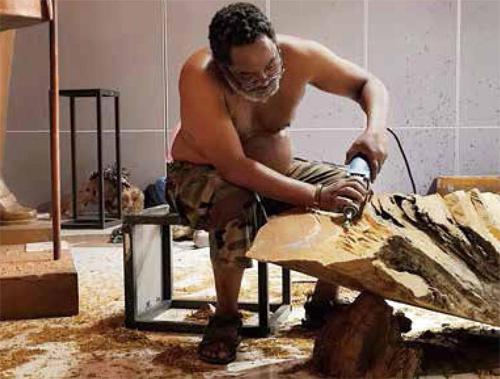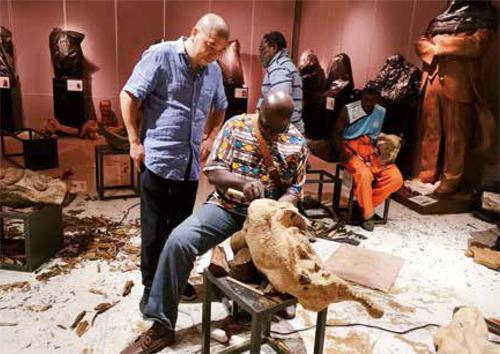从黑非洲到绿江南,一刀一凿刻出文化桥梁
2018-09-06胡昊
胡昊
供职于刚果民主共和国金沙萨美术学院的哈桑可能没有想到,一年之后可以再次來到杭州,继续为期一个月的木雕创作学习交流。
在日前结束的文化和旅游部“对非培训基地”浙江省文化馆第八届非洲艺术家木雕创作交流活动中,哈桑是一年前参加第七届非洲艺术家木雕创作交流活动的9名非洲艺术家中,唯一一位第二次参加该活动的非洲艺术家。
此次交流活动邀请了来自多哥共和国、刚果共和国、刚果民主共和国、加蓬共和国和科特迪瓦共和国的15名木雕艺术家来华进行为期30天的木雕创作交流。通过一个月时间的学习和交流,这些艺术家们在离开的那一刻,对杭州依依不舍。
二度参加,只因能学到真本事
“尽管在同一个地方(程允贤雕塑馆)进行创作,但我们看到的一切都有了变化,而这仅仅只有一年的时间。”在笔者眼里,哈桑并没有什么变化,胡子没变,发型也没变;但在哈桑眼里,浙江的变化真大:“我们去了东阳看木雕,去年还没有的木雕作品,今年有了新的陈设,壁画也加上去了。这让我们觉得,这里创作木雕的速度真快。”
浙江的雕刻最出名的是东阳木雕、乐清黄杨木雕、青田石雕和瓯塑,被合称为“三雕一塑”,而其中木雕就占了两样。非洲艺术家们来学习交流的,就是这两种木雕的创作。因此,位于“中国木雕之都”东阳的中国木雕城,是他们必须“打卡”的地方之一。
哈桑开玩笑说,去年交流学习完,大家都觉得他学到了真本事,不但开拓了眼界,也解决了以前非洲木雕中作品难以保存的问题,“我在杭州学到了在木雕作品外面涂上一层清漆,这样不但增加了雕塑的美观,更可以长久保存木雕作品,防止虫蛀。”去年回国后,哈桑用涂过清漆的木雕作品办了个展览,这对当地的木雕艺术家们冲击很大,“他们才知道,原来木雕还可以这样处理保护的啊。”
哈桑的经历,证明了他在杭州学习交流的成效。因此,今年的第八届非洲艺术家木雕创作交流活动,在当地文化部门和我国驻当地使馆的力促下,他再次来到了杭州。“去年我们学习用陈木进行雕刻,今年我们用树根进行雕刻,都是木雕的一个门类。不管雕刻的是木头的哪个部分,这都是重新赋予木头以新的生命,是一件很有意思的事情。”哈桑告诉笔者,今年回去后,他打算再办一次个人木雕展,而这次展出的地方已经不是刚果民主共和国了,而是放在了比利时的布鲁塞尔。
大开眼界,买下5套切割工具
“来杭州之前,我对中国一无所知,但我知道,这是一个美丽的城市,这里的雕塑有独特的方式。杭州和多哥的雕塑艺术各有各的风格,所以我来了。”多哥艺术家科菲佳已经从事雕塑29年了,他认为,在雕塑的技艺上,其实中国的匠人们已经走在了前面,“在这里,我们看到很多非洲没有的工具。我就想着要把这些东西带回去,给我的同事们开开眼,让他们知道,在遥远的东方,有个艺术上的竞争者存在。”科菲佳举了个例子,他说比如凿子,虽然多哥也有,但质量并不一样,“在杭州用的凿子质量明显更好。”
使用机器来进行木雕创作,是让所有非洲艺术家们最为惊叹的一点。“用机器创作木雕,效果更好。”出生于木雕世家的刚果艺术家马辛戈感叹,他从15岁就开始学习木雕创作。他说,在刚果,大家一般用斧子对木头进行初步的处理,但想要控制力度和角度,对新手来说难度太大了,“有了机器的使用,可以让处理更加精细化,也更适合新手使用。”
来自科特迪瓦的罗内说,机器的使用可以加快工作的进程,“我们那里一般采用砂轮来进行木雕创作,而在这里,他们告诉我们可以采用切割刀。我们是一点一点磨出来,但在这里,艺术家可以直接把不需要的部位切除掉,这样的效率简直提高了三到四倍。”罗内在进行创作的时候,已经能把切割刀用得很顺手了。“我不认为使用机器会让我的作品失去灵魂,相反,我可以更加精准地表达自己的情感,所以这让我对机器不会产生排斥。”
为了能让自己的同事和学生了解木雕创作中机器的使用,罗内委托省文化馆的工作人员小尹采购了5套切割工具,准备带回去,“如果有需要,我会托小尹再帮我采购一些的。”听说罗内采购了5套机器,人均只采购了1套机器的其他非洲艺术家们拍着手开玩笑说:“他可真是个‘富豪。”
短短一月,爱上了杭州和绿茶
“要住一个月其实并不容易,你也知道,非洲不是在中国的边上,我还有5个儿子。”来自加蓬的比洛是这次来杭的15名非洲艺术家中唯一的一名女性,她黑色的头发时髦地挑染了几片红色,“和孩子们分开让人很纠结,但对我来说,这是一次惊喜的发现之旅。”比洛告诉笔者,在杭州的一个月,要比自己曾经在南非学习的一个月更有收获,也更值得,“不过杭州的互联网质量很好,我随时随地可以视频聊天,看看我的儿子们。”
比洛还收获了意外的惊喜,她在杭州度过了自己的生日。那天晚上,省文化馆的工作人员专门为比洛准备了蛋糕。当工作了一天的艺术家们走进餐厅准备吃饭的时候,整个餐厅的灯全暗了,省文化馆工作人员推着生日蛋糕,唱着生日歌走了进来。那一刻,远离家乡几千公里之外的比洛感动得像个孩子一样哭了,妆都哭花了。
在杭州住了一个月,艺术家们对于杭州这个城市的评价都很高。科菲佳说,这个城市确实很不错,景色很美,人也很好,“每次我们到外面去,安排逛一个小时,但总是会超时,因为一路上都是找我们合影的人,大家都太热情了。”科菲佳说,唯一需要吐槽的,就是杭州太热了。“比多哥还热,你看我都晒黑了。”科菲佳开玩笑说,这个印记应该不错。
短短的一个月的时间,一些非洲艺术家爱上了喝茶,尤其是绿茶。他们在吃午饭的时候,都喜欢泡一杯中国绿茶。“在非洲,很多人喜欢中国的茶,大家都喜欢‘吃茶。”马辛戈告诉记者。工作人员后来告诉记者,这些非洲艺术家们说喜欢“吃”茶,确实是“吃”,因为他们不但喝茶水,最后还会把茶叶嚼嚼咽了。
在聊天中,艺术家们都很感激2015年12月约翰内斯堡峰会带来的“文化红利”,可以讓他们远渡重洋来到中国,把非洲和中国的木雕技艺相融合。当年的约翰内斯堡峰会提出,要加大对非洲文化领域的人力资源培训力度,中方将实施与非洲文化交流“千人计划”。
从那年开始,浙江省文化馆作为文化部首批“对非培训基地”,连续承办文化部“博茨瓦纳学员刺绣培训班”“非洲学员竹编培训班”“非洲学员陶艺培训班”“非洲艺术家木雕创作交流”等活动,均获得良好反响,为中非文化交流拓宽了渠道,充实了内容。
哈桑告诉笔者:“我们期待今年在北京的中非合作论坛,希望能够从中获得更多的文化交流的机会,让非洲文化和中国传统文化能够更加深入地开展交流。”
African Sculptors Engaged in Cultural Exchanges in Zhejiang
By Hu Hao
Tshamala Mpoyi Hassan came to Hangzhou in June 2018. It was his second visit. A woodcarving artist from an art academy in Kinshasa, the capital and the largest city of the Democratic Republic of the Congo, he was one of the seven African woodcarving artists who in 2017 took part in a workshop in Hangzhou sponsored by the Ministry of Culture and Tourism and Zhejiang Cultural Center. This year, Hassan took part in another 30-day workshop in Hangzhou.
In June and July 2018, 15 woodcarving artists respectively from the Togolese Republic, the Kingdom of Kongo, the Democratic Republic of the Congo, the Gabonese Republic, and the Republic of C?te dIvoire gathered in Hangzhou to go through a 30-day workshop.
Hassan immediately noticed the fast changes in Zhejiang he hadnt seen a year before. “We are in the same place (Cheng Yunxian Sculpture Gallery) to work out our new creations, but we see a lot of changes,” commented Hassan. “Last year we visited Dongyang to see woodcarving there. This year, we saw new artworks and we even saw frescos. We know how fast woodcarving artists in Zhejiang are working.”
In terms of sculpture and carving, Zhejiang boasts woodcarving of Dongyang, boxwood carving of Yueqing, stone carving of Qingtian, and sculpture of Wenzhou. This year, the 15 African artists explored the secrets of the two woodcarving arts. They visited Dongyang again, the woodcarving capital of China.
Soon after his one-month study in Hangzhou and his return to the Congo in 2017, Hassan held a solo exhibition in Kinshasa. His woodcarving artworks, all coated in varnish, caused a sensation. Local artists flocked in to take a look at the protective coating. They had never known that woodcarvings could be protected this way.
So this year Hassan came again, with the assistance of Chinese embassy in Kinshasa and the cultural authorities of the Congo. “Last year we carved the wood material that had been stored for years. This year we carved on tree roots.” He was planning to hold another solo woodcarving show after the workshop in Hangzhou concluded. But this time, he was to display his woodcarving creations in Brussels, Belgium, after he concluded his study in Hangzhou.
Aboflan Kofiga, a woodcarving artist of Togo engaged in the art for 29 years, was surprised to see something quite new in woodcarving in Hangzhou. “Before I came, I knew almost nothing about China. I knew Hangzhou was a beautiful city and woodcarving here was quite unique. Thats why I came,” remarked Kofiga. “Our Chinese artists are quite advanced. They use tools we dont have in Africa. I will bring these tools back for my colleagues to take a look so that they will know they have competitors in the distant East. “We have chisels in Togo, but chisels used in Hangzhou are of much better quality,” he said.
The most surprising thing these African artists saw and learned about in Hangzhou was that machines could be used in woodcarving. Messengo Guynel Emma observed, “Machines make woodcarving more effective”. He started how to do woodcarving at 15. In the Congo, he said, the axe is used in the first phase of a woodcarving piece. Beginners find it too difficult to finesse the forces and angles. A machine can do a job more sophisticatedly and a beginner can operate a machine more conveniently,” commented Emma.
“We use the grinding wheel back home to create woodcarving pieces, “said Ayebi Kouao Rene from C?te dIvoire. “We learned here that a machine can directly remove the parts that are not needed. This works three or four times faster.” Rene learned how to use a machine to do woodcarving. “I dont think a machine can make my artworks soulless. In contrary, I can express myself more accurately. Thats why I have no reason to dislike machines.” He bought five sets of cutting tools in Hangzhou and planned to share them with his students and friends. He was prepared to buy more through an employee at the Zhejiang Cultural Center if the need arose. The fellow African artists joked that Rene was rich.
Biloghe Mengue Zélia Flore was the only woman of the 15 African woodcarvers at the workshop. She has five sons back home. “It is difficult to be separate from my children. But this is an amazing journey of discovery. Internet in Hangzhou is excellent. I can video-talk with my sons,” she commented, her black hair dyed red in small blocks. Compared with a one-month study in South Africa, the 30-day workshop in Hangzhou was more helpful, she commented. She celebrated her birthday in Hangzhou. When all the artists sat down to dinner after a day of work, the lights in the dining room were turned off, and a cart with a birthday cake on it was pushed in by workers with Zhejiang Cultural Center. People sang “Happy Birthday”. She wept like a child.
The 15 African artists spoke highly of Hangzhou. But “it is hotter than Africa, complained Kofiga, “Look, I am tanned.” Some of them fell in love with tea, especially green tea. They sipped tea and ate up all the tealeaves.
The African artists were grateful to the Johannesburg Action Plan launched at the Forum on China-Africa Cooperation in Johannesburg in December 2015. According to the action plan, “the Chinese side will establish ten major ‘Culture Training Bases for Africa and execute the ‘One Thousand People Program for culture training in Africa”.
It was in 2015 that Zhejiang Cultural Center was designated by the Ministry of Culture as a major Cultural Training Center for Africa. The province has so far hosted eight workshops for the training of African artists engaged in embroidery, bamboo weaving, porcelain, woodcarving, etc.
Hassan of the Congo said, “We are looking forward to the Forum on China-Africa Cooperation this year for more opportunities on cultural exchanges between African culture and traditional Chinese culture”.
